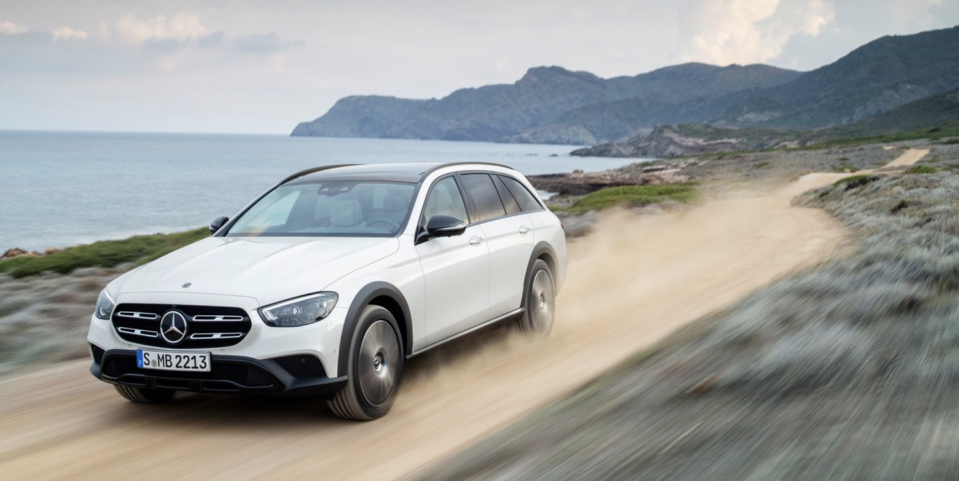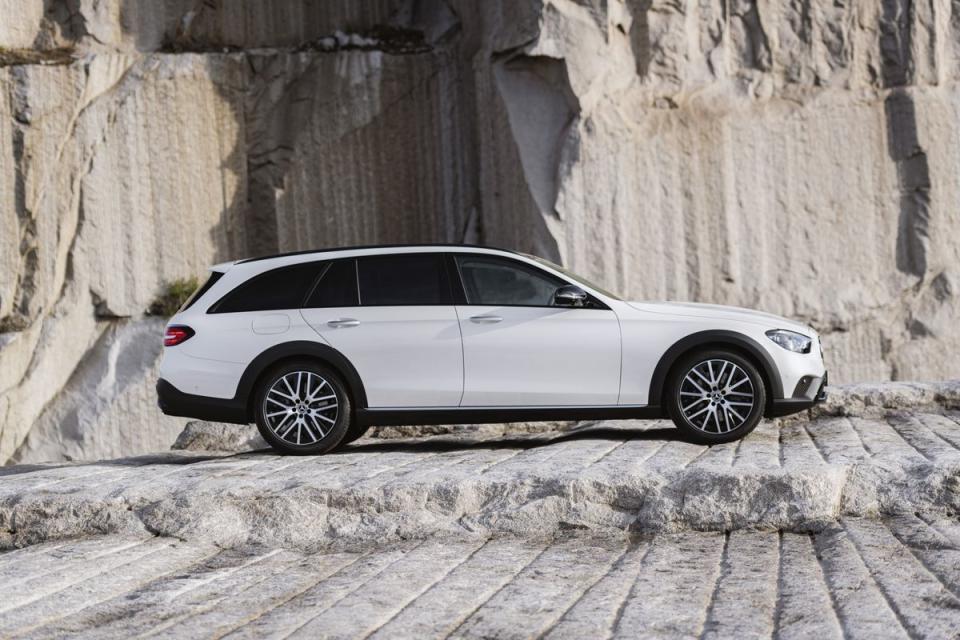Why the Mercedes E-Class Jumped on the Off-Road Wagon Trend

Mercedes-Benz recently unveiled a face-lifted version of its base E-Class Wagon for the U.S. market. Now known as the E450 4MATIC All-Terrain, this update replaces the outgoing E450 Wagon, and thus represents one of the most significant stylistic changes to one of our all-time favorite vehicles.
In addition to inventing the production passenger car back in the 1880s, Mercedes-Benz invented the luxury station wagon, sending fully-optioned versions of the 300T estate to America back in the 1980s. These diesel-powered, seven-passenger long-roofs retailed for around $30,000 at the start of the Me Decade, roughly equivalent to $90,000 today. In the ensuing five decades, and over five successive generations, the Mercedes wagon has remained the standard bearer in the category. This is in part because Benz has remained the only foreign manufacturer that has consistently imported luxury wagons to our shores. But it is also, in our opinion, because of its steadfast resistance what we like to call the "Outbackification" of its signature family hauler.

By this, we mean the addition of jacked-up suspension, a concomitant increase in ride height, and a lower body dipped in cheap plastic cladding. First popularized by the Subaru Outback, the trend metastasized onto such vehicles as the Volvo V70 and V90 Cross Country, Audi Allroad, VW Golf Alltrack, and Buick Regal TourX. Now these features are standard on Benz’s stalwart U.S. wagon offering, clearly intended to convey some semiotic message.
"These days, everybody—doesn’t matter who you ask—likes higher cars, like SUVs and crossovers. And we have quite many SUVs in our portfolio, up to the mighty G-Wagen," said Robert Lesnik, exterior design director for Mercedes-Benz. "So the E-Class All Terrain is kind of the rugged station wagon."

We are not convinced that this is necessarily a good thing. But Lesnik goes on to add a new dimension to our understanding of this model, one that we missed in our initial assessment.
"There is one more big difference compared to the 'normal' station wagon, besides all those physical changes on the exterior and the interior. The car has bigger tires. Not only the rim, the outer diameter of the tire. The base E-Class has 618mm-diameter tires [24.3 inches], but this one has 715 mm [28.1 inches], which is the next bigger size. And the car, when you drive it, of course you sit higher, but the car is much more comfortable because you have more tire. It’s a completely different feeling when you drive the car—and I’m not talking about off-road, but using it on the road, like most people do. So this is something that is a kind of intelligent way of driving an SUV-ish car."

Regardless of this improvement, which we applaud, we find the existence of this styling update somewhat unbecoming on a "stealth wealth" vehicle like the Benz wagon. A Mercedes estate is meant to signify an owner’s refined and understated good taste, their abiding interest in delivering The Best or Nothing for their precious Brazilian Mid-Century Modern daybeds, Waterworks bathroom fixtures, and Bouvier de Flandres puppies. Not their interest in fording a flood-stage rivulet en route to an Overlanding excursion.
"At the end," Lesnik says, "not that many people will go off road, obviously. But the presence is different—its chunky, off-road, rugged style. If you see both cars standing next to each other, definitely one has a bigger feeling. It’s exactly the same size, but you get more."

More is not necessarily better, in this case. By our last count, Mercedes already had approximately 157 separate SUV models on sale in the United States. And, as nice as many of them are—particularly the new GLE 63 and GLS 63 AMG models—it seems to us a borderline indignity that this one standalone model, the only wagon in the three-pointed star’s current domestic lineup, should be forced to ape these mall-crawlers.
So, we asked Lesnik if he ever feels like the crossover and SUV trend is devouring every single other category of vehicle. "Of course it is!" he says. "That’s the reason why there are not even that many MPVs [minivans] around anymore, especially in Europe. People with average taste around the world, the majority are interested in having something like a crossover."
Consider our taste above-average.

Conspicuously absent from Mercedes' recent wagon announcements was any indication of updates to the delightfully absurd, 603-hp Mercedes-AMG E63S Wagon, a vehicle to which we are impossibly beholden. So we wondered, will it get lifted and dunked as well?
"There will be no mixing of All-Terrain with AMG performance cars," Lesnik says definitively. "We will keep them separated, and with different characters. So there will be performance cars coming from AMG—not just the one you mentioned, but there will be more entry-level performance as well," he says. "This is something we are doing in many car segments, and it’s very, very successful. But definitely there will be no mix between AMG63 and All-Terrain." Phew.
Lesnik continues. "The E-Class family is our biggest family of cars, with everything from convertible to coupe to sporty AMG and up to All-Terrain. That’s the point of having different characters, to satisfy all needs."
You Might Also Like

 Yahoo Autos
Yahoo Autos 